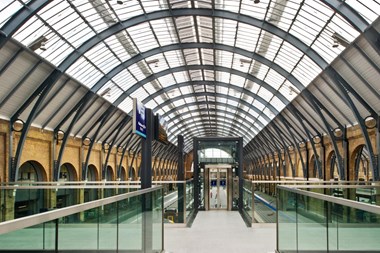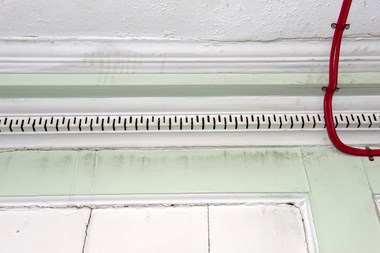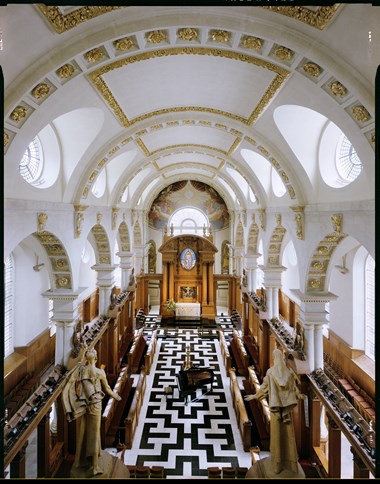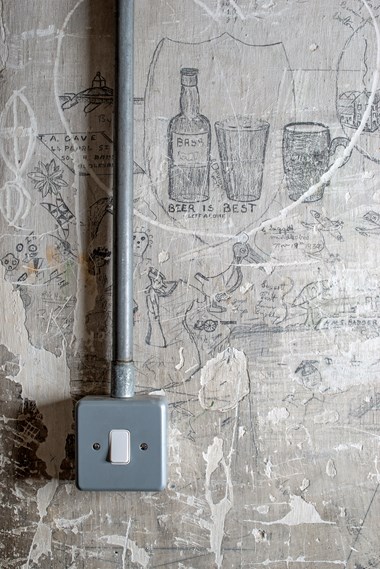Installing New Services
In older buildings it's important that the lighting, power and heating systems remain safe, efficient and suit the current use.
When building uses change, or services come to the end of their life, they will need to be replaced. The removal and replacement must be done in a way that limits damage to the historic fabric of the building.
There's a much wider range of building services in use today than in the past. They include mechanical, electrical and plumbing or public health engineering (sometimes referred to as MEP):
- Communication lines, telephones and IT networks (ICT)
- Gas, electricity, water
- Heating, ventilation and air conditioning (HVAC)
- Lightning and surge protection
- Electrical power systems, distribution boards and switchgear
- Internal and external lighting, including emergency lighting
- Hot and cold water systems
- Drainage, plumbing, and sewers
- Escalators and lifts
- Fire detection and protection
- Security and alarm systems
- Renewable or low carbon technology installations such as solar arrays
Conservation principles and reversibility
The design and installation of building services systems in historic buildings needs to be considered carefully. The historic interest of a building can be undermined by successive installations.
The design and installation should aim to protect the building and its setting with no loss of historic fabric, and follow the principles of mitigation, minimisation and reversibility.
Mitigation considers:
- reusing of existing services’ routes
- using existing features, such as mouldings or balustrades, to conceal services such as pipework and cabling
- using alternative routes for services through voids under floors or above ceilings
- locating discretely new or additional items where their function is not compromised
- using wireless technology for controls that can remove the need for hard-wired connections, however the heavy construction found in some historical buildings may limit the range and detailed signal strength surveys may be required
- choosing accessible service routes and locations to easily allow future maintenance, repair and eventual replacement
Minimisation considers:
- reducing or, better still, removing completely the likelihood of any permanent alterations or scarring to a building, especially those caused by installing heating services
- sharing common routes with other services
- allowing spare capacity in (new) service routes for future works
- routeing pipework, controls or cabling through buildings in ways that might not be the shortest or the most direct, or the simplest
- using the minimum number of fixings into historic fabric
- reducing the impact on historic fabric by making fixings into mortar joints between brickwork, stonework or where least visible
- carrying out the minimum amount of work that would disturb existing fabric and, where this is necessary, re-using as much as possible of the existing fabric as is appropriate and practical
- avoiding destructive chasing or cutting a groove into a surface to install cables or pipes
- installing services so that they don’t cover up, damage or interrupt views of important building features and surfaces or create dirt traps or staining patterns from heat and air movement
Reversibility considers:
- planning for the removal of services at the end of their useful life as well as their installation, both to reduce the harm that could be done to historic fabric
- detailing each intervention such as holes and fixings, noting that fixings into mortar joints, which can be repaired by repointing, may be more appropriate than into brickwork or masonry which cannot be so readily repaired
- the difficulty of installing and eventually removing large items due to their size
Historic England’s conservation principles provides further general guidance.
Design considerations
While the final appearance of the installations is important, it doesn't necessarily have to be designed to look historic. After all, modern services are relatively new as they have only been around for 150 years. Trying to produce a period look to installations may be inappropriate. Why install Victorian style radiators in a Norman church or Tudor house? Well-designed contemporary and innovative installations may be a better solution.
In all cases the design, layout and installation of the building services should respect historic buildings and their settings. It's becoming much easier to successfully integrate services into the building so as to be almost unnoticeable. For example, aspirated fire-detection systems can be installed which do not require detectors being fixed to ceilings. Lighting can be incorporated into or on top of picture rails or fixed furniture, and it can provide not only the normal lighting function but emergency lighting as well. Radio-based CCTV, detection, alarm and control systems can now eliminate the need for extensive cabling.
Designing and building
Before any work starts, carry out a thorough and systematic investigation through both desk-top and on-site surveys. This'll provide a clear and co-ordinated picture of what services and routes exist against what's required. Then determine the extent of invasive work by judging the value of the improvement in building services to be gained, against the damage and disturbance to historic fabric.
The design of new building services within historic buildings should take advantage of any existing openings and services routes. If new openings are necessary, the designer should ensure that as many services as possible share a common route through the building. This will minimise the loss of historic fabric. And if you design in spare capacity, you will ensure, at least in the short term, that further loss of building fabric is contained.
Where the building design offers suitable routes, a surface installation may sometimes be a better solution. For example mouldings, column capitals, cornices, or balustrades can disguise a carefully installed cable or pipe. However it's important to ensure that an installation of this type does not cover up, damage or interrupt the view of important building features and surfaces. Take care not to create any dirt traps or staining patterns from heat and air movement.
You must agree the routes and the methods of fixing with the property owner. You may also need statutory consents for a listed building or scheduled monument. The building services consultant/designer should record the agreed routes and fixing methods on the design and working drawings and where relevant the Building Information Model (BIM). They must also ensure that the installation is carried out in accordance with these drawings.
Energy efficiency
The building regulations and the associated ‘approved documents’ must be regarded as the minimum standard for building services works. Where feasible, energy efficiency improvements should be made, subject to achieving a payback within five years or less. Energy assessments will need to be made using calculation methods such as SAP, SBEM, BREAM, Energy Efficiency Ratio (EER), and Seasonal Energy Efficiency Ratings (SEER). For new heating systems a full cost benefit analysis over 25 years (the typical life of much of heating plant excluding pipework and static heat emitters such as radiators) will be required using techniques such as discounted cash flow.
Equipment and spares
Equipment should be sourced so that delivery times for replacements are not a problem and spares will be easily available. On-line research for the reputation of equipment being considered may be helpful – equipment that generates lots of negative comments is probably best avoided. Spare parts may be available despite what manufacturers and service contractors say.
Image gallery
Please click on the gallery images to enlarge.
Archaeological considerations
When installing new services like gas, electricity and water give careful consideration to known or suspected buried archaeology. An archaeologist may need to be in attendance during the excavation works. A Written Scheme of Investigation (WSI) may be needed which will set out the archaeological recording work. Allow time to liaise with the archaeologist during the excavation works.
Learn more
Building services engineering systems are sometimes viewed as causing damage and an intrusion; especially when considering historic buildings. However, they are now a necessity in many situations to meet the expectations of our society. Even before decisions are made on the actual systems to be used there are a number of key questions and considerations.
The Building Services: principles and decision making webinar held on 26 May 2020, looks at some of these sometimes conflicting issues and how they feed into the decisions made for the building services engineering required.
The Building Services: installation webinar held on 23 June 2020, looks at how to control the internal environment and how this influences the decisions on the design and methods of installation for the building services engineering systems.
The Building Services: maintenance and inspection webinar held on 28 July 2020, looks at some of the things to consider in actually installing the services, and what is needed after the services have been installed.
For the best experience, please use Google Chrome browser or download Adobe Connect.









